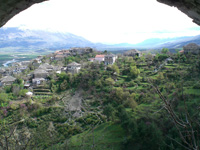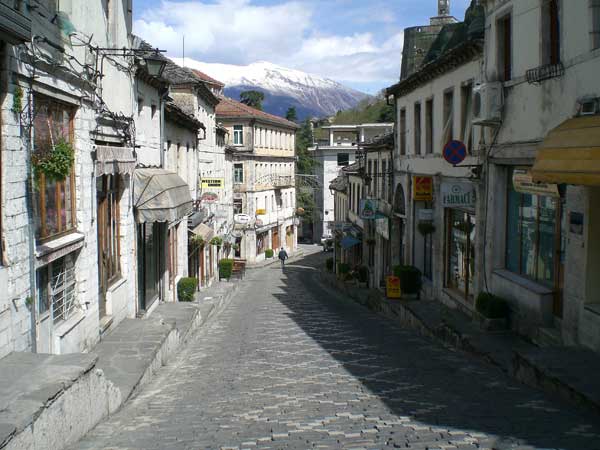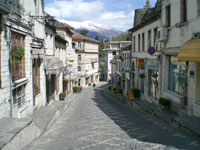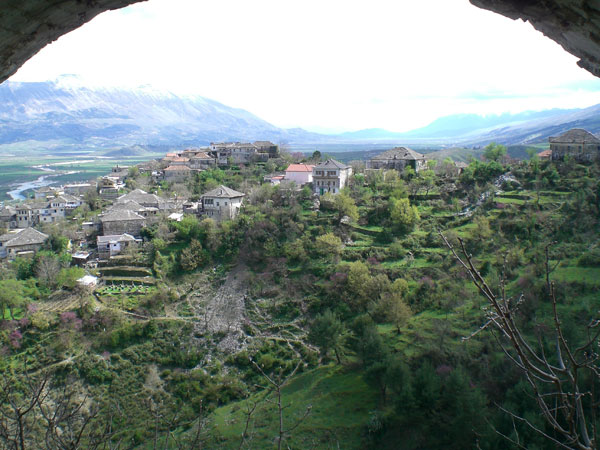| | Robert Elsie | AL Art | AL History | AL Language | AL Literature | AL Photography | Contact | |
Robert Elsie
Texts and Documents of Albanian History
BACK | AL History

View from the fortress of Gjirokastra
(Photo: Robert Elsie, March 2008)
1670
Evliya Chelebi:
Seyahatname
- a Journey to Gjirokastra
The Ottoman Turkish writer Evliya Chelebi or Çelebi (1611-1684) travelled extensively through the Ottoman empire and neighbouring countries from 1640 to 1676 , both in a private capacity and at the service of the Sublime Porte. The account of his travels is recorded in his ten-volume Turkish-language Seyahatname (travel book), which he completed in Cairo. The Seyahatname contains a wealth of information on the cultural history, folklore and geography of the countries he visited. In 1670, Evliya travelled through southern Albania on a mission to muster troops and workmen to protect the Mani Peninsula in the Peloponnese, recently conquered by the Ottomans. Coming from the coast and Delvina, he first arrived in Gjirokastra, which he described in some detail.

The mighty and famous fortress of Gjirokastra. In Greek, it means .... . Its initial founder was the son of Philip, one of the Greek kings. It later fell into the hands of various rulers and finally, in the year .... was seized from Albanian rebels by Sultan Bayazid II the Saint in person. Many buildings in Gjirokastra appear to have been built by the Venetian infidels because you can see portraits of Saint Mark on them, which is the symbol of Venice. In accordance with the survey register of Suleiman Khan, it is crown land belonging to the Pasha of Delvina and is governed by a voyvoda. It has a qadi with a salary level of 180 akçe. The district of Gjirokastra has .... villages. Among the other officials of this town are the grand mufti, the nakibüleşraf, the steward of the sipahis, the commander of the janissaries, the market inspector, the collector of tolls, the mayor, the poll-tax official, the chief architect, the subaşı, the warden of the fortress and 200 garrison troops. The fortress is an old stonework construction situated along the ridge of a high cliff. The narrow building has a circumference of 1,400 paces and stretches from east to west, with a length of 600 broad paces and a width of 100 paces. Its long, solid ramparts resemble a galley. Inside the fortress there is only one main street running from east to west. Ranged on both sides of the street are 200 two-storey stonework houses, roofed entirely with slate. Within the fortress is the Mosque of Sultan Bayazid II the Saint (1), with a slate roof and a stone minaret. It is a large old mosque with a spiritual atmosphere and is 80 feet long and 40 feet wide. Inside it there are four carved columns and a wooden ceiling of joined beams with very fine decoration.
Since the fortress is situated on the top of a high cliff, water is collected in a huge cistern at the foot of the minaret. All the houses within the walls get their drinking water from this source, i.e. from rain water that flows into this sea-like cistern. Each house has its own private cistern as well.
The fortress has two gates with three strong and solid iron doorways each. The eastern gate is approached by a stone staircase, and for this reason horsemen have difficulty entering and leaving by this gate. At the third doorway, which is the innermost, there is a pavilion from which one can look out over the whole district. It is here that all the foremost and distinguished citizens assemble and feast their eyes on the gardens and vineyards in the plain below. On the western side is the gate in front of the public prayer-grounds. It also has three iron doors. On this side, between the prayer-grounds and the fortress is a shallow moat, 100 paces long and 20 paces wide. There are no moats on the other three sides as they have very steep cliffs.
Within the fortress there are 200 houses with slate roofs, built on the ramparts of the fortress. These houses have alcoves and bay windows from which you can look way down at the town to the left and right, and at the verdant plain below.
The open town of Gjirokastra. In front of the eastern gate of this fortress, down a steep embankment, is the quarter of the infidels, called the Little Town (Küçük Varoş). It consists of 200 ill-omened spacious homes. Under the cliffs to the north of the fortress is the old bazaar, called the Fortress Bazaar, consisting of 40 little shops. This bazaar has wooden gates at both ends which are much like those of a covered market and which the watchmen close every night. Once the gates are closed, there is no way of getting from the open town up to the fortress on this side. Only the gate on the side of the prayer-grounds is accessible. Farther down, in Big Town (Büyük Varoş) is the newly constructed bazaar of Memi Bey, so they call this area Memi Bey Town. It consists of 150 modern houses with slate roofs, embellished with gardens and vineyards. They are magnificent mansions. This quarter is also the site of the Shari’ah courthouse, which was also endowed by Memi Bey.
Old Big Town. The open town is situated on eight hills and valleys all around the fortress with multi-storied stonework houses, all with slate roofs and surrounded by vineyards and gardens. Each of these well-built houses has a tower. The walls of the courtyards of these houses are constructed of a kind of white granite, hewn out by master stonecutters as though they were Ankara bricks from a single mould. Both rich and poor have such walls. Such square-cut stone is to be found nowhere else on earth except in the cities of Tyre and Magnesia in Anatolia.
Names of the quarters of Gjirokastra. There are 8 quarters, including Palorto, Vutosh, Manalat, Hadji Bey - which is the largest of all, Dunavat (Dundar) and - up the slope - Memi Bey. (2) They are all very prosperous.
Mansions of the nobles. In the eight above-mentioned quarters, there is a total of 2,000 houses with slate roofs, the grandest of all being the new and magnificent mansion of Memo Pasha, then the mansions of his son Osman Bey, of the alay bey and of Zâim Beko. There are many others as well.
Congregational mosques. There are eight prayer-niches in all. Up in the fortress is the Mosque of Sultan Bayazin II the Saint. On a column is the following inscription in celi script: “Seven hundred householders from this town fell in the battle of Candia as martyrs to the faith. Their houses are closed down. And seven thousand servants from this town also quaffed the cup of martyrdom in Candia.” Indeed, many homes are closed down and their servants have married their former masters’ wives.
On the right side of the prayer-ground, atop a steep cliff at the end of a promontory, is the Mosque of Hızır Aga, (3) a fine building with a stonework minaret.
Below that, at the foot of the bathhouse, the Mosque of Hadji Murad. (4) It is reached by way of a stone staircase. It is a lofty stonework building with a well-constructed minaret and a fountain of excellent-tasting water. Inside the mosque the ceiling is finely decorated.
The Tekke Mosque: (5) it has a large congregation, but no minaret. This mosque can be reached by way of a six-step stone stairway. It is a place of worship built in the old style. The courtyard of the mosque is full of various kinds of tall trees and the sun cannot penetrate it at all. It has a well with excellent-tasting water. Around the courtyard are the cells of a Halveti tekke and on one side are the graves of many saints and notables. It so happened that just at this time a young boy in my retinue died. I washed his body with my own hands and buried him in this graveyard. When the Albanians saw me do so, they were repelled and cried, “You washed the dead!” I replied, “But he did not have the plague. He died of dysentery,” swearing to them again and again to convince them.
The Mosque of Memi Pasha, built in a rather narrow part of the new bazaar, is a small, modern and attractive building, holding no more that 100 men. It has a well-proportioned minaret of carved and decorated stonework. It never lacks a congregation. The people in this part of Albania are quite addicted to prayer.
The Mosque of Palorto (6) is a very nice building.
The Mosque of Vutosh is large and old. These are the best-known congregational mosques.
Neighbourhood mosques. There are 7, the best-known being those of Berki Efendi, Vutosh, Memi Bey and the Alay Bey.
Hadith schools. There are 3 schools training ulema, including the Bayazid Khan medrese and the Memi Pasha medrese.
Primary schools. There are 5, including the Big School at the foot of the Bayazid Mosque in the fortress, the Palorto school and the bazaar school.
Dervish lodges. There are 3 tekkes for adepts and dervishes. The most famous is the Tekke Mosque Lodge, whose sheikh, Abdullah Efendi, is a devout and great man.
Markets and bazaars. There are 200 pretty shops in all. Apart from that, the new bazaar has 80 modern two-storey shops. This attractive bazaar has strong gates on both ends like those in a covered bazaar.
Fountains. There are 5 fountains with excellent-tasting water.
Merchant guest-houses. There are 5 khans. The best known and most reliable is the khan of Memi Pasha.
Salubrious climate. The town has a very good climate and, for this reason, its inhabitants have healthy bodies. The boys and the girls here are famous for their beauty. But the water supply is not sufficient for the whole town. The inhabitants resort to the Dropull river which flows through the vineyards down on the plain, where they go continually to fetch water with horses and donkeys. In short, the five fountains are far too few for this town.
Baths. There is one bathhouse which only operates during the winter and closes in the month of July. One other bathhouse was abandoned. But there are many private baths in homes which are sometimes used for ritual bathing.
Churches. There are 3 small churches in the quarters of the infidels.
The Dropull river, flowing northwards along the plain of Gjirokastra from the village of Zavaraho (7) at the other end of the plain, is joined by the Yenice river. Later, across from the fortress of Tepelena, they are joined by the Vjosa river.
After uniting, these three rivers flow northwards and are joined near the Bay of Vlora by the Kuruçay (8) river and then flows into the Bay of Vlora.
Shrines. Foremost among the pilgrimage sites in the town are the tombs of Berki Efendi in the courtyard of the Tekke Mosque, of Popo Baba Sultan, Baba Hasan Dede Sultan and Ali Dost Dede, also in the Tekke Mosque. These are the best-known holy men.
Legend of Sheikh Ali Dost Dede. When Ali Dost Dede died, the whole population of Gjirokastra, convinced that he had expired of the plague, took to the hills and the villages in the countryside, leaving the blessed body of the great saint unburied in his cell for forty days and forty nights. Later, some of the citizens returned from the countryside and ventured to open the door of the cell. What should they see but the corpse of Ali Dost lying there, pointed in the direction of Mecca, and the blessed body still warm and fresh. All the populace of the province marvelled at this fact. Certain generous benefactors prepared the corpse for burial. While they were completing the ritual cleansing of the body, they noticed the words “Ali Dost” (Ali the Friend) inscribed by some divine quill on a portion of red flesh on the saint’s chest. The whole population marvelled at this wonder and washed and buried the saint in the courtyard of the Tekke Mosque, to the accompaniment of prayers and incantations. Even today people come from all parts to visit the site. May his mystery be sanctified.
A marvel. If someone in the town of Gjirokastra should happen to have a pimple or a boil, all the people say that he has the plague and flee from him. No one allows him in. Even his closest neighbours take flight. Only when they are assured that he has some other illness will they approach and inquire about his health. No one enters the home of anyone who has had the plague for up to two years, and even when this period has passed, they still cleanse the house with vinegar, disinfect it with various aromatic herbs, tear down and rebuild various parts of the house, and whitewash all the rooms with lime before entering. Strangely enough, the inhabitants of this town rarely die of the plague, but rather of dysentery, food poisoning, inflammation and fever. Despite such illnesses, the people here live long lives. There are those here who reach 170 years old and are still going strong, though somewhat reduced in vigour. They shave until age 70 or 80. Even the most fragile old men brazenly gird on arms and ride or hike up into the Kurvelesh mountains to put down Albanian rebels or to fight the Venetians infidels. They are courageous ghazis.
I was told that they also despise and curse old Muawiya and Yazid, (9) although I never observed this. Like the people of Paramithiá (10), they never wear blue clothes, nor do they eat zerde (11) or drink boza (12) because these were invented by Muawiya - or so they claim. Despite this, those who sell boza in Istanbul are all Albanians (13).
Another strange custom. The people of Gjirokastra mourn their dead relatives for forty or fifty, indeed up to eighty years. Every Sunday, all the relatives of the dead person gather in a jerrybuilt house, paying professional mourners who weep and wail and keen and lament, raising a great hue and cry. No one can stand to be in town on Sundays because of all the noise and uproar. I dubbed Gjirokastra the ‘city of wailing.’ It is a great wonder how the professional mourners manage to weep and wail with such feeling - more than for their own relatives - for someone who has been dead a hundred years and to whom they are not even related. And how they lament! It is only when they are exhausted with hunger that they desist. When they finish their lamentations, they have the home owners prepare various pastries, including pişi, jamuk, and qumështuar, and also saffron-flavoured sweets to be distributed in town from house to house. These dainties are offered free of charge to rich and poor alike and to all travellers and sojourners on Sundays for the sake of the spirits of the dead. This is a generous deed, to be sure, but mourning for someone who died one hundred years ago seems to me quite pointless. Nonetheless, every country has its own rites and traditions.
They themselves relate the following: One day, while having sex with his wife, a man inopportunely happened to remark, “Tomorrow is Sunday, my dear.” His wife, underneath the fellow, suddenly called to mind her seventeenth husband who had been killed in the naval battle in the Mediterranean between Ottoman admiral Jafer Pasha and some English galleys in the year 1043 A.H. [1633-1634 A.D.]. While still engaged in intercourse, she began tearing her hair, crying, “Oh, how I long for my poor dear seventeenth husband, with whom I lived for forty years and who was martyred in the ghaza. I had such good sex with him!” She raised such a ruckus and bathed the pillow with so many tears that the poor fellow went limp and, mourning the loss of his virility, now regretted that he had mentioned it was Sunday.
It is for this reason, I divined, that the men in Gjirokastra all have a mournful and sombre look. There is hardly any good cheer and friendly feeling, although there are many brave young men among them. There are people of much knowledge here, in particular a good number of poets, of whom Bükâyi, Figani, Nalishi, Sükûni and Feza’i (14) still reside in this city and excel in various skills. Nalishi is without peer in both ghazals and qasidas.
Most of the people of Gjirokastra are devoted to Ali and to the family of the Prophet. They sit down proclaiming, “Ya Ali!” and stand up proclaiming, “Ya Ali!” They can all read Persian. Because they so love Ali and the family of the Prophet, one group secretly curses Muawiya and openly curses Yazid - at least this is what I was told, although I never heard it myself. These people are very fond of pleasure and carousing. They shamelessly drink wine and other intoxicating beverages, such as the one called reyhania. (15)
Another bad habit of the people of Gjirokastra. In weddings, on festival days of St George (16), Nevruz, St Demetrius, (17) and St Nicholas, and on the two feasts of Bairam, they put on their finery and drink various alcoholic beverages. Lovers go hand in hand with their pretty boys and embrace them and dance about in the manner of the Christians. This is quite shameful behaviour, but it is their custom, so we cannot censure it.
Men’s clothing. The old men wrap a turban around their heads and dress in every colour except blue. They stroll about in manly fashion wearing buttoned trousers. Young men wear a short-sleeved shirt and a very short-skirted, pleated undergarment of red silk and satin. They leave their arms and thighs uncovered, so their private parts are quite public. Only a silk shirt with white hems covers them down to the groin. Other parts of their bodies show immodestly through the very thin shirts and breaches they have on. These breaches - so-called - hardly covers their knees. They are actually trousers, wide in the lower part and like a white sheet tied around the loins. To urinate or defecate - if you will excuse the expression - they do not even need to undo the drawstring. In short the young men have very strange outfits, but they are also very chaste. The men are a race of warriors and do not have illicit relations with either boys or women. As for their wives, when they die they go out the door to the tune of “He is one and has no partner,” (18) otherwise they never leave home from the day they are born until the day they die. I disregard their mourning and wailing every Sunday, as mentioned above. They do not even visit their parents’ house, so chaste and virtuous are they, the likes of the saintly lady Rabi’a Adawiyya. (19)
Comestibles and construction techniques. The best known foods and drinks are wine, reyhania, Polish arrack, white Albanian rolls (simid), white flatbread baked in red-hot coals, and aromatic grapes called saralı. The manner in which the outer walls of all the homes are constructed has no parallel in all the world. They are all twenty ells high (20) of red sandstone blocks, just stone with no mud, lime or plaster. The walls and the houses are all centuries old, dating from the time of the infidels. The walls are so tall and solid that not even a sparrow can get a claw hold. Being up in the high mountain pastures, the climate here does not allow for the cultivation of lemons, oranges, pomegranates and olives.
There remains no trace of this mosque. Also known as the Tekke or Partizani quarter. This mosque in the Cfak quarter no longer exists, though there are remnants of a mausoleum (tyrbe) there. No longer extant. This Tekke Mosque, rebuilt in the mid-eighteenth century, survived at least until 1967 and was subsequently demolished. A puppet theatre now stands at the site of the mosque. Unidentified site. Now called the Shushica river. When he later reached this river near Mekat, Evliya called it the Aksu river. Umayyad caliphs. Cursing them would be a sign of fanatical Shi’ite tendencies. Turkish Aydonat, a town in northern Greece. In Evliya’s description of Aydonat, shortly before the section here translated, there is no mention of these customs. A sweet gelatinous dessert coloured and flavoured with saffron. A beverage made of fermented millet. This statement contradicts what Evliya says in his description of the boza sellers of Istanbul, that they are Tatars and Gypsies. All names signifying ‘weeper, lamenter,’ etc. Only Sükûni (roughly ‘Silent’) does not fit the pattern. An alcoholic drink which Evliya later describes as “red grape must produced by boiling grapes of various kinds.” It may perhaps have been flavoured with sweet basil, Turkish reyhan. The drink, Alb. rehaní, is still consumed today. Rûz-i hazir, or chidr, i.e. 23 April. Qâsim, i.e. 26 October. i.e. the funeral prayer. Ascete and saint, d. 185 [801 A.D.]; proverbial for chastity. Approximately 15 metres. [Extract from: Robert Dankoff and Robert Elsie (ed.): Evliya Çelebi in Albania and Adjacent Regions (Kosovo, Montenegro, Ohrid), Leiden 2000, p. 71-87. Translated from the Ottoman Turkish by Robert Elsie and Robert Dankoff.]

